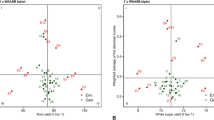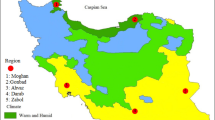Summary
The stability-variance statistic, ĝs 2i , measures the contribution of the ith genotype to genotype x environment interaction. In addition to the knowledge of cultivar stability for an agronomic trait, information on whether stability of one trait can be used to predict stability of another should be useful to breeders. Three separate groups of data, respectively involving CP 79 series, CP 80 series, and CP 81 series experimental clones of sugarcane (Saccharum spp.) were used in this study. Rank-correlation coefficients (rs) between ranks of genotypes for ĝs 2i 's for paired traits indicated in both plant-cane and ratoon crops that stability of tons per hectare of sugar can be predicted from the stability of tons per hectare of cane (THC) and also, to a lesser extent, from the stability of stalk number. The stability of THC also can be reasonably well predicted from the stability of stalk number. Brix stability may give some indication of the stabilities for percentage sucrose and sugar concentration (SC). The ĝs 2i 's for percentage sucrose and SC were almost identical in the CP 79 and CP 81 series (rs varied from 0.93, P<0.01, in plant-cane crop for CP 79 series to 0.98, P<0.01, in plant-cane crop for CP 81 series). Whether correlations were based on ĝs 2i 's estimated across locations within crops or across crops, the magnitude of rs was about the same. Means of various traits were not correlated with their respective ĝs 2i 's (for CP 81 series), indicating that identification and selection of high-yielding sugarcane genotypes with a relatively high degree of stability of performance across test environments should be possible.
Similar content being viewed by others
References
Arceneaux G (1935) A simplified method of making theoretical sugar yield calculations. In accordance with the Winter-Carp-Geerligs formula. Int Sugar J 37:264–265
Casler MD, Hovin AW (1984) Genotype x environment interaction for reed canarygrass forage yield. Crop Sci 24:633–636
Eagles HA, Frey KJ (1977) Repeatability of the stability-variance parameter in oats. Crop Sci 17:253–256
Kang MS (1985) SAS program for calculating stability-variance parameters. J Hered 76:142–143
Kang MS, Miller JD (1984) Genotype x environment interactions for cane and sugar yield and their implications in sugarcane breeding. Crop Sci 24:435–440
Kang MS, Miller JD, Tai PYP (1983) Genetic and phenotypic path analyses and heritability in sugarcane. Crop Sci 23:643–647
SAS Institute (1982) SAS User's Guide: statistics. SAS Institute, Cary NC
Shukla GK (1972) Some statistical aspects of partitioning genotype-environmental components of variability. Heredity 29:237–245
Author information
Authors and Affiliations
Additional information
Communicated by G. S. Khush
Cooperative investigation of the Univ. of Florida, Everglades Research and Education Center, Belle Glade, FL, USA; Louisiana Agricultural Experiment Station, LSU Agricultural Center, Baton Rouge, LA, USA; and Sugarcane Field Station, Canal Point, FL, USA. The field work reported in this study was done when the senior author was affiliated with the University of Florida. Florida Agric. Exp. Stns. Journal Series No. 5933
Rights and permissions
About this article
Cite this article
Kang, M.S., Glaz, B. & Miller, J.D. Interrelationships among stabilities of important agronomic traits in sugarcane. Theoret. Appl. Genetics 74, 310–316 (1987). https://doi.org/10.1007/BF00274712
Received:
Accepted:
Issue Date:
DOI: https://doi.org/10.1007/BF00274712




